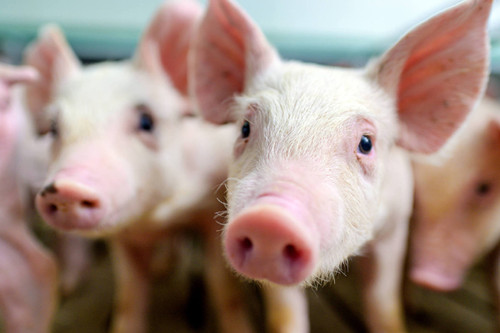Echinacea purpurea is a kind of wild flowers of compositae that originated in America, also known as American Cone Flower, also known as “Echinacea”, is a perennial herb and usually rose or purple. Its medicinal history can be traced back to the period of North American Indians in the 18th century. It is the best medicine for treating trauma, snake bite, headache and cold and now it has been an immune promoter and immunomodulator prevailing internationally now.
At present, with the development of echinacea additions, the echinacea herb and its extracts have been used in livestock breeding because of its strong immune regulation, is an ideal immune enhancer and the main substance to resist disease for poultry and pigs. The main functions are(Take the pig for example):
- It can resist the viral infection of sows. By inhibiting the replication of the virus in the body, purify the virus in the body such as cirrus, blue ear, swine fever and so on. In addition, it can improve the maternal antibody and milk quality of sows.
- It improves the health and resistance of piglets. Echinacea extract can promote the immune activity of T lymphocyte, B lymphocyte and macrophage, enhance the immune response and immune level of the body, and improve the health level and anti-stress ability of the whole pig. Solve all kinds of viral diseases of sows and piglets.
- Adjuvant treatment of other viral diseases. It has a strong auxiliary therapeutic effect on nameless high fever, swine fever, blue ear, circus infection.
How does echinacea work? Let’s start from the chemical composition and pharmacological action of echinacea:
Through the known studies, the chemical composition of echinacea includes polysaccharide and glycoprotein, caffeic acid derivatives, alkyl amide and many other components.
Polysaccharides and glycoproteins
Two immune-stimulating polysaccharides (PS ⅰ, PS ⅱ) were obtained by systematic isolation and pharmacological activity test of water extracts from echinacea. Structural analysis showed that PS ⅰ was 4-methoxy-glucaldehyde-arabinos-xylan, and PS ⅱ was acidic arabinos-rhamnose-galactoglycan. A xyloglucosaccharide with a relative molecular weight of 79 500 was isolated from the leaves and stems of echinacea, and pectin – like polysaccharide was obtained from echinacea juice.
Three glycoproteins were isolated from Echinacea purpurea with relative molecular weights of 17 000, 21 000 and 30 000 respectively, containing about 3% protein. The main sugars were arabinose (64% ~ 84%), galactose (119% ~ 513%) and glucosamine (119% ~ 513%). The protein part mainly contains aspartic acid, glycine, glutamic acid and alanine.
Caffeic acid derivative
Caffeic acid derivatives are the main active components of echinacea, including chicory acid, chlorogenic acid, caffeic acid, echinacea glucoside, artichoke and isochlorogenic acid. Chicory acid is the main active component in the aboveground parts of the echinacea. The content of chicory acid in echinacea flowers and roots was 1.2% ~ 3.1% and 0.6% ~ 2.1%, respectively. Caffeic acid derivatives can enhance immunity, antibacterial, anti-inflammatory, antioxidant and free radical scavenging and antiviral effects, used for the treatment and prevention of infection caused by various pathogens, especially for upper respiratory tract infection.
Fatty amides
The other main active ingredient in Echinacea purpurea extract is aliphatic amide with two double bonds of carbonyl conjugative group. The research on this kind of chemical ingredient was started by looking for a pesticide, which was found to have significant immune-enhancing activity, so it has been extensively and deeply studied. The highest content of these compounds in Echinacea echinacea by HPLC was 0.10040% ~ 0.10395%.
Immune activity
The results showed that the polysaccharides obtained from Echinacea purpurea herb can stimulate macrophages to release TUMOR necrosis factor α (TNF-α) and interferon β, and regulate the production and transformation of lymphocyte stimulation. Preparations made from echinacea SAP have been shown to increase the activity of granulocytes and macrophages in human and animal studies. In the experiment of phagocytosis of granulocytes in vitro, the phagocytosis rate of echinacea root extract (0.1-1mg /mL) was increased by 33%-47% after co-culture with echinacea root extract for 45 min. CD69 antigen expression assay showed that when the concentration of echinacea root extract was 0.1mg/mL, the activation rate of T-inhibitory cells and NK cells was 80% and 147%, respectively.
Anti-inflammatory activity and antibacterial activity
Echinacea is traditionally used as an anti-inflammatory in North America and Europe. Echinacea extract showed obvious anti-inflammatory effects in glacial acetic acid-induced vascular permeability model, carrageenin induced swelling model and LPS-induced TNF-α secretion model of rat megophils. Through the tumor inhibition test in mice and the determination of serum TNF content, the botanists proved that echinacea can significantly inhibit the production of TNF in mice, and inferred that echinacea can have anti-inflammatory and anti-allergic effects. In mice infected with candida albicans treated with echinacea polysaccharides, the number of n. albicans in the kidney of mice decreased significantly 24h later, indicating that echinacea polysaccharides can resist n. albicans infection
Antiviral activity
The scientists found that echinacea extracts have inhibitory effects on herpes simplex virus type I exposed to visible and ultraviolet light, especially against influenza virus, herpes virus, vesicostomatitis virus, Sackie B virus, and poliovirus.
Echinacea extract can improve pig productivity, protect pig immune organs and phagocyte function, enhance T cell immune function and improve antibody level. Two hundred piglets weaned at the same time were divided into four groups with echinacea supplemental levels of 0, 0.5%, 1.0% and 1.5%, respectively. Blood samples were taken every 10 days to measure antibody levels while observing performance. Piglets were immunized with classical Swine fever vaccine and blue ear vaccine at 20 and 50 days of age.
The results showed that echinacea had no significant effect on the survival rate of weaned piglets, but significantly increased the daily gain (>10%), and reduce the feed-to-meat ratio (>5%). In the echinacea group, neutrophils in blood of pigs increased significantly. Echinacea can obviously improve the non-specific immunity of pigs. Blood samples were collected at 30, 40, 50, 60, 70 and 80 days of age to measure the antibody levels of CSFV and blue ear. At the age of 60 days, the antibody level of CSFV and blue ear antibody in the echinacea + 1.5% group were significantly better than those in the non-echinacea + 1.5% group, and the antibody production in the echinacea + 1.5% group was faster and lasted longer.




